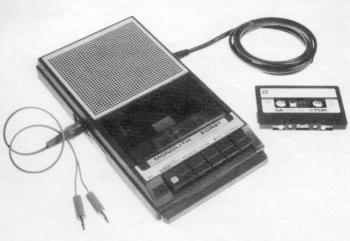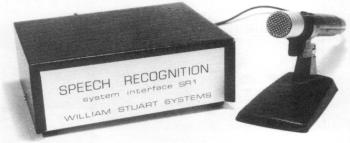| hardware overview |
To lead into in-depth analysis of hardware products, Stephen Adams scans the market
THERE has been no shortage of developments on the hardware side of the market since the introduction of the ZX-81 in March, 1981. Most were based on designs which developed on the ZX-80 and enhanced by the introduction of the ZX-81. The main differences between the ZX-80 - even with the 8K ROM - and the ZX-81 are the appearance of a static screen on the ZX-81 - slow mode - and the extension to the expansion bus - the edge connector at the back of the ROM CS line which meant that some of the Sinclair address decoding should be sorted-out externally to the ZX-81.
For the first six months or so, firms were very cautious about the ZX-81, watching the market to see whether it would take off. The first product to appear was a sound board, complete with input/output port and a motherboard from Quicksilva; that was one of the first motherboards for the ZX-81 and meant that the user could have more than just the Sinclair 16K RAM pack on the back.
The next announcements appeared in September, 1981 at the Personal Computer World Show - floppy discs, RS232 serial printer port, cheaper input/output ports and, for the first time, the Sinclair printer. Since then things have snowballed; ZX-81 sales have exceeded the 250,000 mark, showing that there is a great deal of feeling for the micro and the number of firms which have been set up to deal with ZX-81 equipment has more than doubled since September.
The ZX Microfair in November was an event which meant that the equipment which was promised in the glossy advertisements available previously only on mail order could be seen before purchasing. Such was the enthusiasm for that type of Microfair by both the exhibitors - Sinclair alone took more than £8,000 in orders on one day - and the users that another was organised quickly for January.

A cassette recorder developed for the ZX-81. |
A word of warning to users - be wary of certain manufacturers who claim that they have a product available when all they are doing is testing the market to see if anyone is interested. It is better to write and confirm on what date they will be able to supply the product to you.
Computer manufacturers have the tendency to quote a date and then supply the product between six and 12 weeks after you have paid. Bigger firms are the main culprits.
I have divided this review of the hardware products available for the ZX-81 into three headings - essential add-ons, keyboards, motherboards and extra RAM. They comprise input and output capabilities where some technical knowledge is assumed; enhancements which require programming skill, but either plug direct into the ZX-81 expansion bus or the ZX-81 is modified by the manufacturer.
There are two leaders in the amount of RAM you can cram into the ZX-81 memory map. The Memotech 48K RAM pack has the largest continuous Basic memory; not all of it can be used for a Basic program - only the bottom 16K (16K-32K). The rest has to be used for storing data but not machine code.
Audio Computing has the largest memory pack available, 128K of RAM but only 32K of it available at any time. To switch between sets of 32K, called banks of memory, a manual switch has to be thrown and the ZX-81 has to be re-set to start up the Basic system again. That is not very convenient, as it cannot yet be operated from software or the variables transferred from bank to bank.
The Memotech 48K was one of the packs I have tested; it was good value at £129 plus VAT, assembled, and is very easy to use.
So the arrival of Memotech's 64K pack must be welcomed, especially as it retails for only £79 including VAT. More about this newly-released product soon.
There are other external RAM packs varying from an extra 3K giving a total of 4K of RAM to a full 16K of RAM cheaper than Sinclair's. Always check that the RAM pack does not prevent you connecting other equipment after it is fitted to the expansion bus. That was the case with the Sinclair RAM pack, which meant that you had to spend at least £10 to attach anything else to the ZX-81. If you are spending money you might as well look at the expansion possibilities after you have it.
The only other RAM extension possible is to change the 1K of RAM chips fitted into the basic ZX-81 for a 2K chip. That necessitates going inside the ZX-81 and perhaps some soldering. After checking inside to see if you have one chip - just change the original chip for the new one - or two - a new 28 pin IC socket needs to be fitted - change one strap on the board. Full instructions usually are given with the kits. The new memory chip will cost at least £7 and RAM packs start at £18.
Various keyboards can be obtained which are basically of the same construction, consisting of 40 professional microswitches mounted on to a bare printed circuit board. That replaces the keyboard on the ZX-81. Usually some soldering has to be done. The new keyboard usually is very light to the touch and extremely responsive, improving the time taken to enter a program by at least 50 percent. None of the original keyboard functions are lost as they are all controlled from software.
There is a wide selection of input/output ports available which can provide from 16 to 24 bits of information on a separate bus to the ZX-81 databus. Those outputs are latched; they keep the data the same while the ZX-81 does other things.
They are the only way of getting information in and out of the ZX-81 to control other equipment. They can be divided into two types, memory-mapped - can be PEEKed and POKEd from a Basic program - and input/output-mapped - using special machine-code routines.
Now various attachments can be used on those ports; A/D converters which take a voltage, measure it and give out a digital number for the ZX-81 to read, D/A converters which take a digital number and output a voltage corresponding to it. Light pens can be used to draw on the screen by checking the light received against the screen layout at the time. Most of those require some technical knowledge to be able to use them.

Speech input from William Stuart systems. |
Macronics disc system will act like a super-fast tape recorder using specially-written machine code routines. They will be stored in ROM and can be used to SAVE, LOAD and store random data on 5¼in. disc. The maximum is 40K per disc and the cost is expected to be £249. It also includes the only RS232 printer port available; it will accept data only one bit at a time but many printers are available for it.
There are various attachments to the ZX-81 which, although not essential, can improve the facilities available to the programmer. The newest must be the speech input by William Stuart Systems and the speech output by DCP. That means that you can program the ZX-81 to accept words like LIST, RUN and the like and have it reply in a limited number of words.
Another facility is to have a colour board by Haven Hardware, which is programmable in 16 colours. Programmable character generators can create high-resolution graphics, which can then be printed-out by the very good quality Sinclair printer. Each dot on the screen can be specified, so the resolution can be 512 by 256.
The Sinclair printer uses an aluminium-coated paper with all the characters being shown by black dots. Even without the character board, it can print your own-designed characters but that takes a good deal of memory.
Digital cassette recorders can be bought, designed specially by Monolith for the ZX-81. They are given a registered number and are highly-tuned. If you still want to use your own recorder, Abacus has a cassette switch which will prevent confusion when SAVEing or LOADing.
Motherboards can be plugged easily into the expansion port to give you more sockets, so that all those devices can plug into the ZX-81 all at once.
With all those products it is pleasant to see that one manufacturer, at least, is sufficiently concerned to contact other firms to agree some kind of standard. If you intend to produce something, why not speak to Nick Lambert of Quicksilva?
The final enhancement is more of a service than a product. It is called the Buffer Shop and has been set up in London to cater only for the ZX machines. It is the only retail outlet for products, apart from W H Smith, supplying only the Sinclair ZX-81 and 16K RAM pack.
A greater need for any user is more knowledge about what is available. It is only through co-operation of manufacturers with magazines such as Sinclair User that the user of a ZX-81 can make a valid judgement. I can only say that I have done my part and now it is up to you.